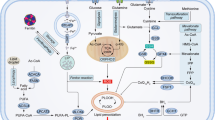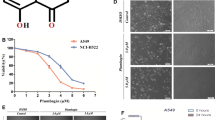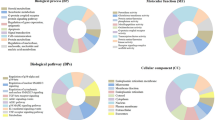Abstract
Clinical and experimental data suggest that salicylic acid (SA) is tumor preventive and NO has a multitude of effects on tumor biology. Therefore, firstly, the aim of our study is to explore the important role of SA in apoptotic induction of liver cancer cells. Secondly, we investigate whether SA mediates the anti-tumor effects by NO signaling pathway. The liver cancer cell line was treated with different concentrations of SA. Cell proliferation was tested using MTS assay and cell apoptosis was assessed by flow cytometry. NO content and NOS activities were measured by biochemical assay. The anti- or pro-apoptotic regulator gene expressions were analyzed by real-time PCR. Our data illustrated that high concentration of SA significantly inhibited liver cancer cell proliferation accompanied by apoptosis induction. In addition, SA led to the release of NO and the increase of NOS activities in above process. Importantly, SA up-regulated a series of apoptosis-related gene expression and reduced the mRNA level of HMGB1. Meanwhile, we also found that NOS inhibitor L-NAME and NO scavenger cPTIO attenuated the above SA-induced effects. Thus, we provided the evidence that SA exerted anti-tumor effects in liver cancer cell in part mediated by the NO pathway.






Similar content being viewed by others
Abbreviations
- SA:
-
Salicylic acid
- NO:
-
Nitric oxide
- NOS:
-
Nitric oxide synthase
- L-NAME:
-
NG-nitro-l-arginine methyl ester hydrochloride
- cPTIO:
-
2-(4-Carboxyphenyl)-4,4,5,5-tetramethylimidazoline-1-oxyl-3-oxide potassium salt
Reference
Ambs S, Merriam WG, Bennett WP, Felley-Bosco E, Ogunfusika MO, Oser SM, Klein S, Shields PG, Billiar TR, Harris CC (1998) Frequent nitric oxide synthase-2 expression in human colon adenomas: implication for tumor angiogenesis and colon cancer progression. Cancer Res 58:334–41
Annemijn MA (2012) Effects of regular aspirin on long-term cancer incidence and metastasis: a systematic comparison of evidence from observational studies versus randomised trials. Lancet Oncol 13(5):518–527. doi:10.1016/S1470-2045(12)70112-2
Choi HW, Tian M, Song F, Venereau E, Preti A, Park SW, Hamilton K, Swapna GV, Manohar M, Moreau M, Agresti A, Gorzanelli A, De Marchis F, Wang H, Antonyak M, Micikas RJ, Gentile DR, Cerione RA, Schroeder FC, Montelione GT, Bianchi ME, Klessig DF (2015) Aspirin’s active metabolite salicylic acid targets high mobility group box 1 to modulate inflammatory responses. Mol Med 18(21):526–535. doi:10.2119/molmed.2015.00148
Chung YM, Bae YS, Lee SY (2003) Molecular ordering of ROS production, mitochondrial changes, and caspase activation during sodium salicylate-induced apoptosis. Free Radic Biol Med 15;34(4):434-42.
Cory S, Adams JM (2002) The Bcl2 family: regulators of the cellular life-or-death switch. Nat Rev Cancer 2:647–656. doi:10.1038/nrc883
Elder DJE (1996) Differential growth inhibition by the aspirin metabolite salicylate in human colorectal tumor cell lines: enhanced apoptosis in carcinoma and in vitro-transformed adenoma relative to adenoma relative to adenoma cell lines. Cancer Res 56:2273–2276
Elwood PC (2009) Aspirin, salicylates, and cancer. Lancet 373:1301–1309. doi:10.1016/S0140-6736(09)60243-9
Elwood PC, Morgan G, Pickering JE, Galante J, Weightman AL, Morris D, Kelson M, Dolwani S (2016) Aspirin in the treatment of cancer: reductions in metastatic spread and in mortality: a systematic review and meta-analyses of published studies. PLoS One. doi:10.1371/journal.pone.0152402
Ferenci P, Fried M, Labrecque D (2010) World gastroenterology organisation guideline. Hepatocellular carcinoma (HCC): a global perspective. J Gastrointestin Liver Dis 19:311–317
Giampieri R, Restivo A, Pusceddu V, Del Prete M, Maccaroni E, Bittoni A, Faloppi L, Andrikou K, Bianconi M, Cabras F, Berardi R, Zorcolo L, Scintu F, Cascinu S, Scartozzi M (2016) The role of aspirin as antitumoral agent for heavily pretreated patients with metastatic colorectal cancer receiving capecitabine monotherapy. Clin Colorectal Cancer. doi:10.1016/j.clcc.2016.07.011
Hagos GK, Carroll RE, Kouznetsova T, Li Q, Toader V, Fernandez PA, Swanson SM, Thatcher GR (2007) Colon cancer chemoprevention by a novel NO chimera that shows anti-inflammatory and antiproliferative activity in vitro and in vivo. Mol Cancer Ther 6(8):2230–9. doi:10.1158/1535-7163.MCT-07-0069
Jenkins DC, Charles IG, Thomsen LL, Moss DW, Holmes LS, Baylis SA, Rhodes P, Westmore K, Emson PC, Moncada S (1995) Roles of nitric oxide in tumor growth. Proc Natl Acad Sci U S A 92:4392–6
Jiang WW, David S (2006) The role of IFN-a and nitric oxide in the release of HMGB1 by RAW 264.7 cells stimulated with polyinosinic-polycytidylic acid or lipopolysaccharide. J Immunol 177:3337–3343
Karmohapatra SK, Chakraborty K, Kahn NN, Sinha AK (2007) The role of nitric oxide in aspirin induced thrombolysis in vitro and the purification of aspirin activated nitric oxide synthase from human blood platelets. Am J Hematol 82(11):986–95. doi:10.1002/ajh.20955
Kanwar JR, Kanwar RK, Burrow H, Baratchi S (2009) Recent advances on the roles of NO in cancer and chronic inflammatory disorders. Curr Med Chem 16(19):2373–94
Klampfer L (1999) Sodium salicylate activates caspases and induces apoptosis of myeloid leukemia cell lines. Blood 93:2386–2394
Klessig DF (2016) Newly identified targets of aspirin and its primary metabolite, salicylic acid. DNA Cell Biol 35(4):163–6. doi:10.1089/dna.2016.3260
Klotz T, Bloch W, Volberg C, Engelmann U, Addicks K (1998) Selective expression of inducible nitric oxide synthase in human prostate carcinoma. Cancer 82:1897–903
Li W, Han W, Ma Y, Cui L, Tian Y, Zhou Z, Wang H (2015) P53-dependent miRNAs mediate nitric oxide-induced apoptosis in colonic carcinogenesis. Free Radic Biol Med 85:105–13. doi:10.1016/j.freeradbiomed
Llovet JM, Burroughs A, Bruix J (2003) Hepatocellular carcinoma. Lancet 362:1907–1917
Mc Menamin ÚC, Cardwell CR, Hughes CM, Murray LM (2015) Low-dose aspirin and survival from lung cancer: a population-based cohort study. BMC Cancer 15:911. doi:10.1186/s12885-015-1910-9
Moncada S, Palmer RM, Higgs EA (1991) Nitric oxide: physiology, pathophysiology, and pharmacology. Pharmacol Rev 43:109–42
Nathan C (1997) Inducible nitric oxide synthase: what difference does it make? J Clin Invest 15:2417–23. doi:10.1172/JCI119782
Palmer RM, Ferrige AG, Moncada S (1987) Nitric oxide release accounts for the biological activity of endothelium-derived relaxing factor. Nature 327:524–6. doi:10.1038/327524a0
Paterson JR, Lawrence JR (2001) Salicylic acid: a link between aspirin, diet and the prevention of colorectal cancer. QJM 94:445–448
Puglisi MA, Cenciarelli C, Tesori V, Cappellari M, Martini M, Di Francesco AM, Giorda E, Carsetti R, Ricci-Vitiani L, Gasbarrini A (2015) High nitric oxide production, secondary to inducible nitric oxide synthase expression, is essential for regulation of the tumour-initiating properties of colon cancer stem cells. J Pathol 236(4):479–90. doi:10.1002/path.4545
Reveneau S, Arnould L, Jolimoy G, Hilpert S, Lejeune P, Saint-Giorgio V, Belichard C, Jeannin JF (1999) Nitric oxide synthase in human breast cancer is associated with tumor grade, proliferation rate, and expression of progesterone receptors. Lab Invest 79:1215–25
Sims GP, Rowe DC, Rietdijk ST, Herbst R, Coyle AJ (2010) HMGB1 and RAGE in inflammation and cancer. Annu Rev Immunol 28:367–388
Tan J, Zeng Q, Jiang XZ, He LY, Wang JR, Yao K, Wang CH (2013) Apoptosis of bladder transitional cell carcinoma T24 cells induced by adenovirus-mediated inducible nitric oxide synthase gene transfection. Chin J Cancer Res 25(5):593–9. doi:10.3978/j.issn.1000-9604.2013.10.11
Vakkala M, Kahlos K, Lakari E, Paakko P, Kinnula V, Soini Y (2000) Inducible nitric oxide synthase expression, apoptosis, and angiogenesis in situ and invasive breast carcinomas. Clin Cancer Res 62:408–16
Wink DA, Cook JA, Christodoulou D, Krishna MC, Pacelli R, Kim S, DeGraff W, Gamson J, Vodovotz Y, Russo A, Mitchell JB (1997) Nitric oxide and some NO donor compounds enhance the cytotoxicity of cisplatin. Nitric Oxide 1(1):88–94. doi:10.1006/niox.1996.0108
Xu W, Liu L (1998) Nitric oxide: from a mysterious labile factor to the molecule of the Nobel Prize. Recent progress in nitric oxide research. Cell Res 8:251–8. doi:10.1038/cr.1998.25
Zamzami N, Brenner C, Marzo I, Susin SA, Kroemer G (1998) Subcellular and submitochondrial mode of action of Bcl-2-like oncoproteins. Oncogene 16(17):2265–82. doi:10.1038/sj.onc.1201989
Zitta K, Meybohm P, Bein B, Huang Y, Heinrich C, Scholz J, Steinfath M, Albrecht M (2012) Salicylic acid induces apoptosis in colon carcinoma cells grown in-vitro: influence of oxygen and salicylic acid concentration. Exp Cell Res 318(7):828–834. doi:10.1016/j.yexcr.2012.02.002
Acknowledgements
This work was supported by Ningbo Medical Project Foundation (No. 2011B05) and the Major Science and Technology Planning Program of Ningbo (No. 2012C50013).
Author information
Authors and Affiliations
Corresponding authors
Rights and permissions
About this article
Cite this article
Liu, Y., Wang, Y., Hu, Y. et al. The apoptotic inducible effects of salicylic acid on hepatoma cell line: relationship with nitric oxide signaling. J. Cell Commun. Signal. 11, 245–253 (2017). https://doi.org/10.1007/s12079-017-0380-z
Received:
Accepted:
Published:
Issue Date:
DOI: https://doi.org/10.1007/s12079-017-0380-z




